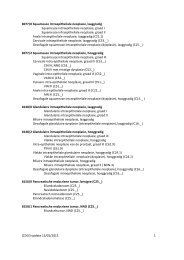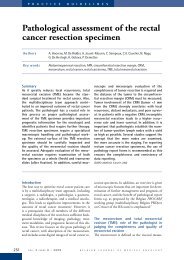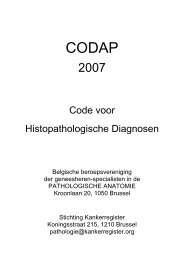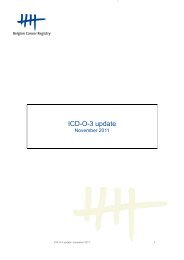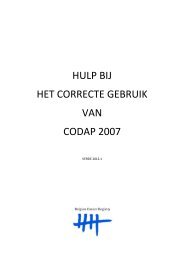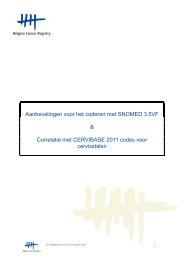Assurance de qualité pour le cancer rectal – phase 2 ...
Assurance de qualité pour le cancer rectal – phase 2 ...
Assurance de qualité pour le cancer rectal – phase 2 ...
Create successful ePaper yourself
Turn your PDF publications into a flip-book with our unique Google optimized e-Paper software.
KCE Reports 81 PROCARE <strong>–</strong> <strong>phase</strong> 2 103Figure 24. Algorithm for QI 1211 (PROCARE database).All patientsN=1071SurgeryN=1058RadicalsurgeryN=1018Documented distancefrom anal vergeN=990 97,1%Surgery?Radicalsurgery?Distance from analverge fil<strong>le</strong>d out?No radicalsurgeryORRadical surgery=MISSINGN=40No documented distancefrom anal vergeN=28No surgeryN=13PROPORTION OF PATIENTS IN WHOM A CT OF THE LIVER ANDCT OR RX OF THE THORAX WAS PERFORMED BEFORE ANYTREATMENTMeasurement in prospective PROCARE databaseVariab<strong>le</strong>s ‘SPR_V141’ and ‘SPR_V143’ register the use of a CT scan or RX respectivelyfor the <strong>de</strong>termination of the cM stage. However, no specification is given for theanatomic region of the CT or RX. Therefore, this QI is not measurab<strong>le</strong>.Measurement in coup<strong>le</strong>d administrative database (Figure 25)A nomenclature co<strong>de</strong> exists for the performance of a CT, however withoutspecification of the anatomic region (Tab<strong>le</strong> 62). On the other hand, specific ICD-9-CMco<strong>de</strong>s exist for CT of the abdomen (not liver!) and thorax (Tab<strong>le</strong> 63). However, theseco<strong>de</strong>s are only availab<strong>le</strong> from the Technical Cell database (see 3.1.2.2), which is adatabase of coup<strong>le</strong>d hospital registration data (i.e. no information on ambulatoryperformance of these tests). Importantly, coding of these procedures is not obligatory.Therefore, using these co<strong>de</strong>s causes an important un<strong>de</strong>restimation of the frequency ofthese tests.In or<strong>de</strong>r to i<strong>de</strong>ntify if the imaging test was done before any treatment, the date of thefirst treatment (surgery, radiotherapy, chemotherapy) after diagnosis should be known(see algorithm). To i<strong>de</strong>ntify if and when a patient un<strong>de</strong>rwent surgery, nomenclatureco<strong>de</strong>s (Tab<strong>le</strong> 64 and 65) or surgical ICD-9-CM co<strong>de</strong>s (Tab<strong>le</strong> 66, 67 and 68) incombination with diagnostic ICD-9-CM co<strong>de</strong>s (Tab<strong>le</strong> 69) were used. For radiotherapy,nomenclature co<strong>de</strong>s were used (Tab<strong>le</strong> 70), since for only 12 patients ICD-9-CM co<strong>de</strong>srelated to radiotherapy (Tab<strong>le</strong> 71) were found. For chemotherapy, the CNK co<strong>de</strong>s ofthe HIC database were used (Tab<strong>le</strong> 72). An important prob<strong>le</strong>m with the Technical Celldatabase is the absence of the exact date of the procedure.



